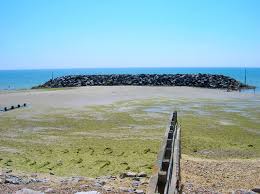Imagine a world consumed each day in a washing machine of tidal violence, where daily battles are fought over scraps of food and shelter. Where shells, suckers and tentacles outnumber backbones. Such a place exists today. It is called a rockpool. And it is a writhing hotbed of weirdness: a place where new creatures are swapped about with mind-bending irregularity.
Here, boneless animals such as the bootlace worm grow metres in length or, like the velvet swimming crab, come armed with fierce red eyes, razor sharp pincers and an attitude to match.
Here, crabs decorate their shells with seaweed providing an amazing hairdo of camouflage, and some of the animals, like the snakelocks anemone, photosynthesise. Here, sea slugs steal poisonous cells from other creatures and wear them on their back like armour.
This is their world, not ours. And it is an interesting place indeed.
Thrown into their twice-daily tidal maelstrom, rockpool dwellers must make the most of every opportunity they get. Their sex lives reflect that. Many, like the sea slugs, are hermaphrodites, able to put every encounter with a fellow of the same species to good use by having dual sexuality. Then there are the slipper limpets, an alien invader that pumps out special chemicals to attract passers-by, forming a literal ‘sex train’ of up to 25 individuals.
Shelled creatures occupy pride of place in most rockpools. There are shelled worms (bristleworms), shelled tiny crustaceans (barnacles, who kick food into their mouths with their legs) and shelled larger crustaceans, such as the hermit crabs, locked in a ceaseless quest for ever more suitable housing.
Here are the Elmer Beach rocks and sea defenses.
In most habitats on Earth, a shell is a guarantee of safety. But in a rockpool no shell is safe from the drilling mouthparts of the dog whelk (a monstrous kind of rock snail), or the pneumatic crowbarring of a starfish’s inside-out stomach.
These are deliciously nightmarish creatures, easily observable to anyone with a little bit of patience or a dab of luck.
There are some vertebrates, of course. You might spot the shadows of darting gobies or blennies, or a pipefish lying amongst the weed. But most will move on in the next tide, to other rockpools, or rocky reefs in deeper water.
Sandy beaches hide similar dramas: cuttlefish bones, necklace shells that, like the dog whelk, drill into their prey, and the dried egg cases of sharks and rays. Cockles abound and some Butterfish, another type of bivalve.
 For me, a trip to the beach is always exciting: the intriguing and fascinating cast of rockpools, and the delightful surprise of the strandline.
For me, a trip to the beach is always exciting: the intriguing and fascinating cast of rockpools, and the delightful surprise of the strandline.
And every tide brings new players and new finds.
Wherever you live there is a Wildlife Trust that covers your area. You can support their work by joining your local Wildlife Trust today. Visit www.wildlifetrusts.org to choose the Trust you would like to join.
To find your own rockpools at LOW TIDE to look at and explore – the best places are:
- Felpham / Elmer Beaches – especially around the rocky sea defences which provide interesting rock pools and islands at low tide ideal to explore for shells, shrimps and crabs.
- Bracklesham Bay at the bottom of the tide (preferably Spring tides – which means early morning or later evening visits to the beach). You can also find fossils here incl sharks teeth!
Plus you can see the remains of many sea animals on the beach – usually around the high tide mark this time – as shells – especially oyster, slipper limpet and whelk shells, the remains of crab shells, cuttlefish endoskeletons and shark egg cases. So keep an eye out when you go for a walk or spend time on the beach!
Sadly you will also see the destructive effects of man on the environment too – lot of washed up plastics, rope, tar and other detritus.
PLEASE REMEMBER TO TAKE ALL YOUR LITTER HOME and dispose of it safely.
© Chichester Self Catering




Leave a Reply